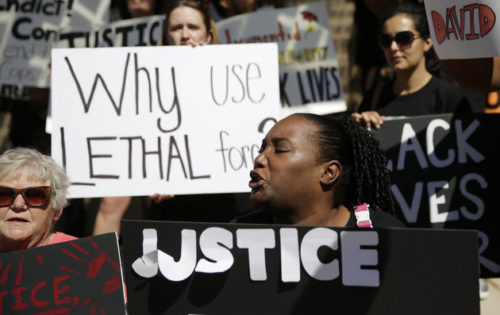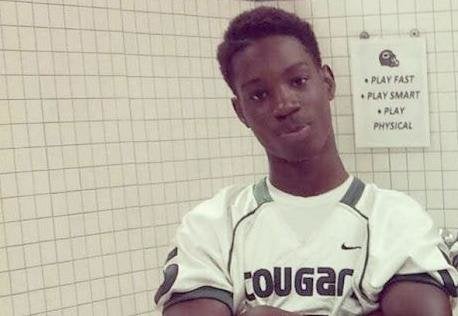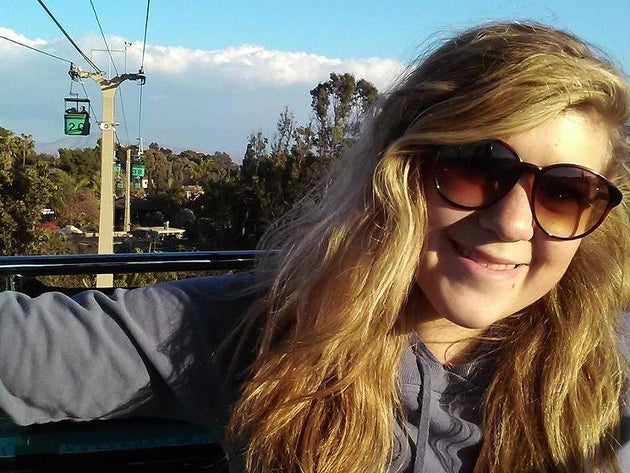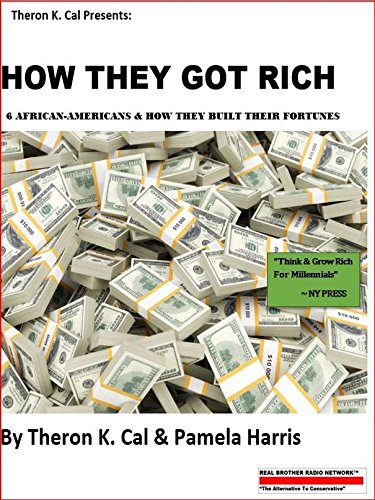
ASSOCIATED PRESS Protesters hold a rally at Austin City Hall in Texas to respond to a police officer fatally shooting 17-year-old David Joseph in February. BY NICK WING & jULIA CRAVEN
 -RACISM & JUSTICE April 19th 2016 Huff Post
-RACISM & JUSTICE April 19th 2016 Huff Post
The call came through Officer Geoffrey Freeman’s radio a few minutes before 10 a.m. on Feb. 8.
“Complaint that somebody jumped a fence and tried to chase a neighbor,” the police dispatcher in Austin, Texas, said. “Black male, tall, thin, wearing jeans, boxers.”
The dispatcher left Freeman with a final detail.
“No weapons,” she can be heard saying just before the call, later released to the public, cuts out.
Freeman headed toward the disturbance, which was taking place in a pocket of suburbia a couple of miles north of the University of Texas at Austin campus.
The last of a series of 911 calls relayed to Freeman reported a “totally nude black male” in the area. Freeman, a 10-year veteran of the force, called for additional units and continued his search.
“Sounds like this guy could either be … 10-86 [subject with mental illness] and losing it or high or something,” he told dispatch, according to a memo later published by Austin’s Citizen Review Panel.
Within half an hour of arriving, Freeman found what he was looking for. He exited his cruiser and confronted David Joseph, who was completely naked and standing in the middle of the street.
After just seconds of verbal contact, Joseph, a 17-year-old known to his friends as Pronto, lay dying on the asphalt. Freeman had shot him through the heart.
Medical examiners would officially describe Joseph as African-American, 5 feet 7 inches tall and 146 pounds. Freeman, 46 years old and also black, stood at the same height, but was nearly 100 pounds heavier than the teen. A toxicology report later found traces of marijuana, the prescription drug Xanax and an antihistamine in Joseph’s system. It’s still unclear what drove him to strip off his clothes and run around the neighborhood.
Joseph is one of the nearly 300 people police have shot and killed so far this year, according to The Washington Post’s unofficial tally. And like the rest of the names on that list, you’re probably not familiar with Joseph or his story.
There was no mention of Joseph on CNN, Fox News or MSNBC on the day he died, or on any day since, according to a Huffington Post review of programming. Instead, cable news gleefully reported that Donald Trump had called his Republican opponent Texas Sen. Ted Cruz a “pussy.” The schoolyard insult prompted numerous segments, including “experts” speculating on whether the billionaire’s vulgarity would sink his candidacy. (It didn’t.)
There have been at least 20 cases in which cops have shot unarmed civilians to death this year, and a HuffPost examination of cable news transcripts found that the major cable news networks have not covered any of them.
“I have yet to speak with a single person — on 10 college campuses — who has correctly identified” any of the victims, Shaun King, an activist and criminal justice reporter for the New York Daily News, wrote in a column earlier this month. “The hashtags and trending topics of police brutality victims that were once a staple from coast to coast have all but disappeared.”
Although the media’s interest in police shootings may have changed, the broad outlines of many of the cases haven’t. According to Freeman, Joseph didn’t comply with his commands to stop, and instead turned and charged. Freeman claimed he feared for his life and had to resort to lethal force, even though he was also equipped with a Taser, pepper spray and a baton. Joseph’s family said the teen needed help, not a bullet to the chest.
Similar accounts fueled controversy in Ferguson, Missouri, as well as other cities including New York City, Baltimore, Minneapolis and Chicago over the past two years. And like those cases, Joseph’s shooting raises many of the same questions about law enforcement’s use of force, training, racial biases and the ability to hold officers accountable for catastrophic misjudgment or misconduct.
Unlike in those cases, however, Joseph has not become a household name or part of a rallying cry in the fight against police violence.
And he’s not alone in his relative anonymity. Although police reform is still on many people’s minds — including the journalists who continue to cover it — mainstream reporting on the issue seems to have shifted away from telling the stories behind the climbing death toll.
Instead, the media has turned its sights to the heated presidential election, burning through the oxygen that had given life to stories about police brutality and reform.
“The election has distracted people and, even worse, the media has just given in to the lowest common denominator to cover every crazy and outrageous thing Trump says at the expense of actually covering issues and concerns,” Sarah Oates, a journalism professor at the University of Maryland, told HuffPost.
It’s not that wall-to-wall coverage of the presidential election has completely undercut the conversation about policing in America. Democratic candidates Hillary Clinton and Sen. Bernie Sanders (I-Vt.) have both reached out to the families of victims of police violence, even recruiting some of them as surrogates. And they’ve both made sweeping — though perhaps unrealistic — promises to enact police reform if elected president. But in the midst of a contentious primary season, they’ve stopped using new examples to illustrate the critical importance of the issue.
The focus was less abstract last year. Police fatally shot 109 unarmed civilians in 2015, according to The Guardian’s unofficial tally, a steady drumbeat of bloodshed accentuated by higher-profile incidents that dominated headlines for days. National attention helped amplify the existing local activism, and under the klieg lights, city and state officials felt pressure to listen to the demands for accountability, transparency and change.
Video footage played an integral role in building that storyline. Last year, the public had little choice but to watch as bystander video of an officer opening fire on a fleeing 50-year-old Walter Scott was broadcast on repeat around the nation. In the days that passed between the Scott shooting and the release of the footage, law enforcement tried to portray the incident as a reasonable use of force. The four-minute cell phone video unwound that narrative, and eventually led prosecutors to charge the officer with murder.
In the cases from this year that HuffPost analyzed, however, there have so far been no publicly released videos clearly showing the shootings — no visual evidence to further force Americans to take a hard look at police violence and potentially challenge the notion that officers are always right. And considering that police are still killing people frequently — in incidents that often sound troublingly familiar — it’s possible that the public has developed a higher threshold for outrage.
While Clinton and Sanders have been less outspoken about issues of police violence this year, they didn’t hesitate to get involved last year. In fact, both candidates appeared to make a point of saying the names of people killed by police, channeling a cause promoted by activists aligned with the Black Lives Matter movement.
But now that Clinton and Sanders are trying to win over voters and build their national appeal, Oates says they’re taking a more delicate approach.
“It allows them to get some votes hopefully without alienating the white majority,” she said of the candidates’ overtures on police reform. “They’re kind of stuck between people who don’t ever want to hear the police criticized and people who really want to say there’s a real problem with the power that’s given to police versus the rights of the citizens.”
This shift can’t be chalked up entirely to a campaign-obsessed media that thrives on vapid political coverage. If there’s one upside to this trend, it’s that police are so far killing fewer unarmed people this year than they were in 2015. But we’re just months into 2016, and we’ve still seen a number of disturbing incidents that under different circumstances, might have resonated beyond the local level.
Take the case of Antronie Scott, a 36-year-old black man who was shot and killed by San Antonio Police Officer John Lee in February, just days before Joseph’s fatal shooting. Lee found Scott, who was wanted on two felony charges, sitting in the parking lot of his girlfriend’s apartment complex. According to Lee, Scott made a sudden turn after he stepped out of his car. Lee says he thought he saw a gun.
It was a cell phone.
Activists in San Antonio held rallies calling for justice, but Scott’s story still failed to permeate the national news cycle. Mike Lowe, a local Black Lives Matter activist, attributes part of this to the fact that the demonstrations there were less disruptive than major protests in Ferguson, Baltimore and Chicago.
“A lot of individuals may not be rebellious or have that spirit of protest in them to be like, ‘We’re just going to occupy the streets until justice happens,’” he said.
Those more confrontational attitudes have paid dividends in other cities, Lowe said. But he says politicians in San Antonio take pride in the fact that the city isn’t like its peers. After Scott’s shooting, Mayor Ivy Taylor, who is black, said in a statement that it was important for San Antonio to not compare itself — and the killing of Scott — to what has happened elsewhere.
“Every city or town also has its own context,” she said. “I will not allow our city’s story to be that of cities we see on the national news.”
“Politicizing this incident and putting it in the context of what’s happening in other cities is not the solution — just as reverting to 20th-century police techniques or protesting the very meetings that seek to provide the opportunity for constructive dialogue is not the solution,” Taylor added.
The mayor sat down with activists to discuss their concerns, and San Antonio’s chief of police said in early March that Lee would be fired. Weeks later, however, he reversed course, saying Lee would face no disciplinary action beyond additional training. Taylor quickly announced that she supported his decision.
The local media landscape has also contributed to the obscurity of many of these cases. Small, often underresourced newsrooms are more likely to prioritize pro-police narratives, which helps explain why their coverage sometimes tends to be linear and uncritical of law enforcement, Oates said.
“You have to build a relationship with the local officials as a reporter. You have to make decisions about which bridges to burn,” she said. “And I’d love to say it doesn’t work that way, but ask any local reporter and they’ll tell you, you’ve got to pick your battles.”
That could be one reason you probably haven’t heard about 25-year-old Kelsey Hauser, who was killed in January by an El Cajon, California, police officer. She was sitting in the passenger seat of a stolen car that was reportedly accelerating toward an officer. Or Calin Roquemore, a 24-year-old killed in February by a state trooper in Beckville, Texas, after exiting his car and trying to flee on foot following a brief chase. Or Cristian Medina, a mentally ill 23-year-old fatally shot in Florence, California, last month after he reportedly pointed his finger at officers like a gun.
All of these individuals were unarmed. And despite concerning details about the circumstances of these shootings, they’ve received only perfunctory coverage from local outlets and none from national sources. The media isn’t asking hard questions of the police, which likely means nobody else is either. Victims’ families are then left to trust that law enforcement will properly handle issues of transparency and accountability on their own, absent outside pressure.
The apparent apathy surrounding new police shooting cases could reflect a lack of interest in the community or in the newsroom itself, or it could simply come down to the downsizing of local media.
“You just don’t have the ability sometimes to cover the basic facts, much less anything more than what the police department tells you,” Oates said, recalling her time as the lone reporter covering crime for the Orlando Sentinel in the 1980s. “It’s really down to the better-resourced media organization to take the bigger picture, gather up the data and try to shift the national agenda on things.”
Lowe agreed with Oates that the presence of national media is often vital in these cases — especially in helping activists in the community achieve their goal of police accountability.
“Once it gets national attention, it’s like, OK, the world is watching,” he said.
A month and a half after Joseph’s death, Austin’s police chief, Art Acevedo, announced that Freeman had been “indefinitely suspended” from the department.
“Officer Freeman chose to confront Mr. Joseph alone [and] … chose to utilize deadly force to Mr. Joseph, even though he knew other officers had yet to arrive but were imminently in route,” read a memo from Acevedo. “Freeman’s decision to draw his weapon when he exited his vehicle was unwarranted. … There were no extenuating circumstances why he could not maintain a safe distance while keeping Mr. Joseph in view.”
Matthew Simpson, a policy strategist for the American Civil Liberties Union in Texas who works on issues of police misconduct, says there could be an upside to the fact that Joseph’s case didn’t get more national attention. While Austin has handled previous controversial police shootings poorly, city officials worked proactively to address the community’s anxiety and anger over Joseph’s killing. They formed a coalition of concerned parties, solicited input from activists and proceeded in a timely and relatively transparent manner to keep the public informed about the case. It seemed like they might have been listening to the message the Black Lives Matter movement has been sending.
“It’s not as interesting a story if there’s misconduct and the police actually handle it appropriately,” Simpson said. “It sort of proves that if individual officers who are bad actors are held accountable, the community is willing to acknowledge that.”
It’s still unclear if Freeman will face criminal charges for the shooting. Last month, he filed an appeal to keep his job.




